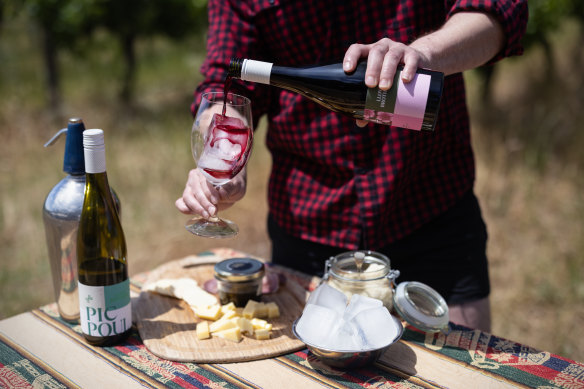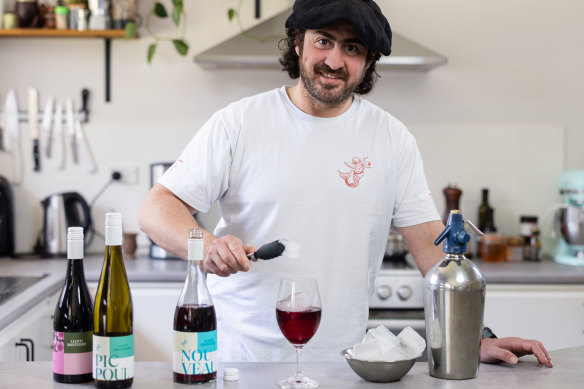Why putting ice in your wine glass could be the hack of summer
It not only dilutes the alcohol content, but can make some grape varieties taste better.
It’s a serving suggestion that might make some wine purists baulk, but putting ice in your glass of wine may be the best thing you do this summer.
Winemaker and Lowe Family Wine Co founder David Lowe believes ice cubes make some wines taste better if the grape variety is right.
Lowe is among a small but passionate group of winemakers experimenting with the concept.

The Mudgee-based biodynamic and organic vigneron had an “aha” moment while participating in Australian wine industry research into the production of low-alcohol wine.
“I was looking at the early harvest of grapes to get alcohol levels down from about eight per cent to about six per cent. The challenge was that alcohol comes from sugar and sugar holds grape flavour. This meant that wines that are light in alcohol are also light in flavour.”
A great deal of time and money went into the research and when Lowe found himself explaining the technicalities of why it wasn’t working, a friend and peer said, “You know, in Italy we just stick an ice cube in it.”
The following week, Lowe stopped his research and focussed on the possibilities of ice in wine.
“After much experimentation, I have found two varieties that are not diminished when I put an ice cube or two in the glass,” he says.

The two shining stars are ansonica and vermentino, grape varieties that are popular in Italy. “The ice chills the wine while keeping the same aroma and intensity of colour, and the taste is just as good, maybe even better,” Lowe says.
“The climate and the varieties that seem to hold up to ice are Mediterranean, specifically Italian.”
The way wines are made is an important factor. “The Italian characteristic gives a slight salty or briny sensation, which prevents the ice from detracting from the wine’s flavour,” Lowe says. “The same can be said for rosé made with Italian red varietals such as primitivo (zinfandel).”
In McLaren Vale, South Australia, Lloyd Brothers winemaker Gonzalo Sanchez is a big fan of ice and soda water in wine. “Every time I go home to Argentina, the first thing I do is get a glass of wine and put soda in it,” he says.
The result is a spritzer known in Sanchez’s homeland as a “sodeado”. “Six out of 10 people in Argentina prefer to drink wine with soda water. It makes so much sense because it means it’s much lower alcohol at a lower price.”
Australia may be late to the game but our warm climate and barbecue culture begs for cool, fresh, lighter drinks.

“We are lucky to be able to get really great wines at very reasonable prices,” Sanchez says.
“There are so many options and so many grapes here – don’t be afraid to experiment. It’s important to remind people that wine can be simple and refreshing. Grab a bottle of wine, a big glass of ice, and a bottle of soda water and make your own blend.”
However, ice and soda do not complement all wine. “Never use a wine that’s too complex, tannic or oaky,” Sanchez says. “The bubbles in the soda water will make the tannins feel harder.”
For that reason, you won’t find Lowe adding ice to his premium Lowe Zinfandel. “You also can’t do it with chardonnay because it gets thinner,” he says.
Tip
Large, super-hard ice cubes (the kind typically used for whisky) work well because they chill fast, and dilute slowly. Never let a glass full of ice fully melt in the sun or you’ll have an insipid, watery mess on your hands.
On the white front, avoid oaky wines and wines high in bitter, astringent flavours (like grapefruit pith). “Our picpoul can go well with soda because of all the acidity, lemon and lime flavours,” he adds.
Cheap and cheerful reds are a winner. “Fresh, easy-drinking wines are best,” Sanchez says. “We use a lot of malbec back at home, and here in Australia a lighter shiraz works well.”
In a world where wine tends to be intimidating, the possibilities are refreshing on all fronts.
“Young people don’t want the wines their parents drink, they want something new and interesting,” Lowe says. “They’re happy to drink wine with an ice cube, and that’s fine by me.”
Wines that work with ice
- Riesling and sauvignon blanc: Don’t ruin a top-shelf riesling, but if the wine is bright, crisp, and has decent acidity, go for it.
- Ansonica: This white variety from Sicily is a winner. Give the Lowe Ansonica, made from fruit from Murray Darling, New South Wales, a whirl.
- Vermentino: A fresh, zippy Italian white that sits between semillon and verdelho. Choose an option with zero oak maturation.
- Rosé: Love the blush stuff? Rosé made with Italian red varietals such as primitivo (Zinfandel) work particularly well, especially as an aperitif.
- Light reds: Cheap and cheerful reds are a winner. Think fresh, easy-drinking wines (minus tannin and oak). Malbec is popular in Argentina, while in Australia, lighter shiraz works well. Lloyd Brothers Nouveau Field Blend’s playful, bright mix of grenache and shiraz is perfect.
The best recipes from Australia's leading chefs straight to your inbox.
Sign up